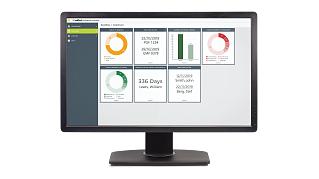





If you operate a fleet with coaches and trucks in the UK, then you strive to ensure compliance with EU rules on drivers’ hours, which regulate driver rest periods and working times. Failure to comply with EU legislation can result in major penalties and other consequences. Our guide to drivers’ hours explains some of the more complex rules, to make it easier for you to understand what’s required.
What’s the purpose of drivers’ hours regulations?
Regulations on drivers’ hours are intended to support driver well-being and increase road safety. Tachographs, which record data such as driving time and distance driven, must be installed in commercial vehicles. By law, tachograph driver cards are required for all commercial bus and truck drivers. These cards store all driver data that’s relevant to compliance, including rest and break times. EU regulations aim to prevent driver fatigue while ensuring that transport companies are competing fairly.

What are the drivers’ hours rules for fleet vehicles?
UK drivers’ hours rules
Driving hours and working time
Per The Working Time Regulations 1998, the UK government requires “adequate rest” for drivers but doesn’t specify an amount of time. There are, however, specific rules on driving hours and working time:
- Drivers may not exceed 10 hours of driving and 11 hours of duty in any 24-hour working day. The 11-hour limit doesn’t apply on days that drivers do zero to 4 hours of driving each day of the week.
- Some drivers are exempt from the 11-hour duty rule but not the maximum driving hours, including doctors and service workers.
- Per The Working Time Regulations 1998, the UK government requires “adequate rest” for drivers but doesn’t specify an amount of time.
Legislative compliance
When a tachograph is not installed in a vehicle that’s driven in the UK only, drivers must keep a written record of their hours. Refer to the UK government website for fuller details.
Even as the UK has left the European Union, your fleet may still need to comply with EU rules on drivers’ hours and tachographs. EU legislation applies to vehicles that weigh more than 3.5 tonnes and that travel within the UK or to, from or through an EU country. EU rules also specify how long your drivers can stay on the road and when they’re required to rest.
To stay compliant, you must regularly download and analyse tachograph data from your vehicle units and driver cards — at least every 28 days per driver and at least every 90 days for every vehicle. Please also see the section below on EU drivers’ hours rules.


EU drivers’ hours rules
According to Regulation (EC) No 561/2006, drivers may not drive longer than 9 hours per day, which can extend to 10 hours no more than twice per week. Also:
- Drivers may not drive longer than 56 hours in one week or 90 hours in two consecutive weeks.
- A driver must take at least 45 hours of rest for each week of driving — and this rest period must start at least 6 days from the end of the driver’s prior rest time.
- Drivers can take reduced weekly rest periods. Within 6 days of the end of the last weekly rest, the driver can take a reduced rest period of 24 hours minimum. This reduction must then be compensated in a single block of time before the end of the third week following the week of the initial reduction and taken alongside an additional rest period of 9 hours minimum.
- Weekly rest hours must be taken continuously, and the driver must not be engaged in any other professional activity during this period.
The legislation mandates daily breaks and rests too:
- For every 4.5 hours of driving time, a driver must break for at least 45 minutes. These minutes can be taken as a single break or in two smaller breaks, one of 30 minutes, one of 15 minutes.
- Drivers must have a minimum rest period of 11 hours for each day of driving. This time can be taken in one period or split in two, in which case the number of hours must total 12 (one rest of 3 hours, one of 9 hours).
- Drivers can reduce their rest period down to 9 hours up to 3 days a week. Daily rest must be taken in total within 24 hours of the driver’s last rest period.
What is classified as working time?
Any activities for which drivers should be paid are considered working time. That includes activities outside their time behind the wheel, whether it’s sitting in driver trainings or doing administrative tasks. Loading and unloading vehicles — and monitoring the unloading or unloading — is working time too. Anything related to vehicle maintenance also counts, such as cleaning the vehicle and conducting daily vehicle checks. Basically, any unknown waiting time or time that drivers cannot freely dispose of is categorised as working time.


Driver hours’ rules for HGVs / trucks
Drivers’ hour regulations apply to many haulage operators and lorry drivers that operate large or heavy goods vehicles, or HGVs. EU legislation applies to vehicles that weigh more than 3.5 tonnes and that travel within the UK or to, from or through an EU country. Within the UK, exemptions include vehicles used by the military, police and fire brigade.
How can you comply with the drivers’ hours regulations?
Digital tachographs are a key tool in helping fleet managers comply with drivers’ hours regulation. Digital tachographs collect various types of data, from vehicle registration numbers to driver activities and incidents like speeding, driving without a driver card and tampering. Data from digital tachographs must be downloaded and analysed on a regular basis. For each driver, download tachograph data at least every 28 days and every 90 days for each vehicle. Explore how digital tachographs can help you comply with drivers’ hours regulations.


Who gets penalised?
Companies that fail to comply with drivers’ hours rules can be fined. In more serious cases, lack of compliance can lead to being jailed or having an operating license revoked. Companies, fleet managers and drivers may all be held accountable for proven transgressions. The employee who oversees scheduling could also be held liable if work isn’t properly timetabled, while the fleet manager would hold responsibility for lack of driver training or not completing standard working time checks.
Webfleet Tachograph Manager
Looking for an easy way to stay compliant with drivers’ hours rules and tachograph requirements? Webfleet Tachograph Manager automates your compliance processes, eliminating paperwork and inspection headaches. With remote downloads, your drivers don’t need to be in certain locations. Reduce the risk of infringements and penalties by managing driving times and compliance deadlines in one place.

What can Webfleet do for your transport fleet?

How to leverage your fleet’s compliance

Want to improve safety and avoid costs? Make the most of your fleet’s compliance with drivers’ hours and tachograph rules - get our quick guide.
Your consent is required
In this section, external content is being embedded from .
To display the content, your consent is required for the following cookie categories:
- Targeted Advertising
- Analytics & Personalization
- Essential
For further details, please refer to our privacy policy. If you are interested in how ###vendor_name### processes your data, please visit their privacy policy.












